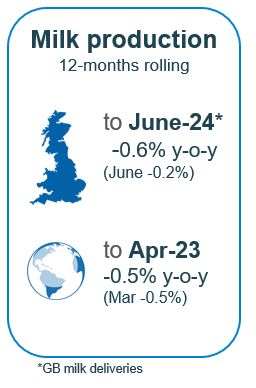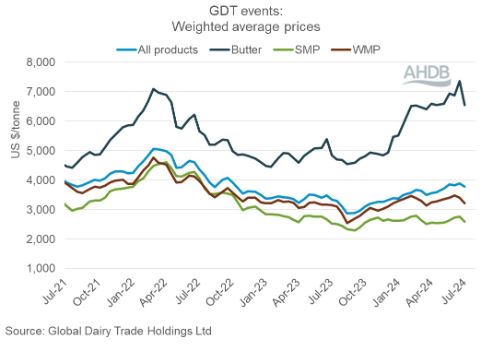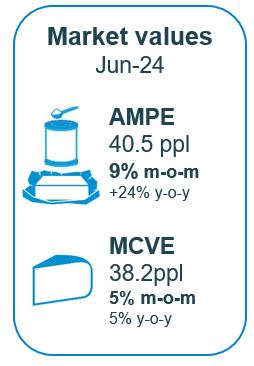Q2 2024 dairy market review
Tuesday, 16 July 2024
Milk production
GB milk deliveries through the milk year to date have contracted in supply terms as a result of the poor weather seen from Autumn through to Spring. April was back by 1.9% and May by 1.0%. June ended the month back by 0.2%. Following weaker production throughout the flush, we saw June deliveries move much closer to year ago levels as the month progressed, due to improved grass availability. We need to remember that we are not annualising on a good year. The 2023/24 milk season was the lowest milk-year volume recorded since the 2016/17 season.
Grass growth rates were poor through Spring but have since come back in line with seasonal averages which should indicate that first cuts, at least, have been successful. Time (and weather) will tell to what extent the slow start and damage to ground will make for prospects for second cuts. This is reflected in the latest forecast as a slightly bigger decline is now expected in GB milk production for the 2024/25 season. To reflect the slow start and challenges of the weather we expect production to decline by 1.0% year-on-year.
Organic production has continued to decline at a higher rate, falling by 11% year-on-year in may and continuing from the last full milk ear tha was down by 11% year-on-year. However, there have been signs of nascent demand emerging as consumer confidence steadily grows. In May, sales of organic dairy milk in retail grew by nearly 4% (Source: Nielsen IQ 12 we 18 May 2024). If this pattern was to continue there could be some shortages in the organic sector meaning some demand for farmers to come back to organic.
The milking herd has stabilised in numbers, standing at 1.66 million head, as of 1 April 2024. The average age of the dairy herd now stands at 4.55 years, down from 4.60 years at the same point in the previous year. This continues the trend of gradual decrease which can be attributed to selecting for productivity in breeding decisions, to continuously improve the national herd.
GB registrations of calves born to dairy dams totalled 406,000 in the first quarter of 2024. This is up 0.7% on the previous year and the highest recorded figure for Q1. The uplift was mostly driven by increased births in January and February, up 1.0% and 2.7% year on year, respectively. Registrations were lower in March, down 1.7% year on year.
We continue to see the move to more block calving systems illustrated in the BCMS data, with registrations in quarter one of 2024 trending above the five-year average. We can expect that the births total in Q2 will be much lower in comparison to Q1 due to the summer seasonality trends.
Over the last ten years, we have seen changes in breeding strategies of the dairy herd, with the industry moving to reduce dairy bull calves and grow dairy beef. BCMS data indicates there has been a steady decline in Holstein Friesian (HF) registrations, from 38% in 2014 to 22% in 2023 driven by the uptick in sexed semen usage. The BCMS data clearly reflects the increased use of beef sires in the dairy herd. In 2023, 56% of calves registered to dairy dams were beef-bred calves, compared to 36% in 2014. This reflects the industry trend, as we have seen an increasing number of dairy producers using beef sires.
Global milk production in April continued the ongoing decline and now sits at -0.5% year on year with growth in the EU and Australia being offset by declines in all the other significant milk exporting regions. This meant that on a 12-month basis milk supplies are now tightening with ongoing lack-lustre demand and higher input costs constraining production in some markets.
Wholesale markets
Overall price movements on UK wholesale markets have begun to push ahead in the latest period. The disappointing peak in milk production has increased concerns about product availability that has driven buyers to act fast to secure supplies and made sellers reluctant to part with product cheaply. Fats drove the positivity with butter up by a huge £580/t and bulk cream by £180/t in June. Mild cheddar was up by £130/t and although SMP continued to lag, it still rose by £550/t to £2,060/t. This indicates a more positive outlook for dairy.
The GDT has continued to push up over the quarter, with butter now being sold at even higher prices than the 2022 peak. Other commodities are still some way off those heights but in 2022 butter also lead the way and the others followed. However, the 2 July event saw a loss in the index of 6.9%, the biggest single movement in the year to date. Although it since rallied slightly by 0.4% it shows that the market direction is far from certain as we head into the slower summer months.
As of June, milk market values (which is a general estimate on market returns and the current market value of milk based on UK wholesale price movements) have marched onwards. AMPE rose by 9%, or 3.5ppl, MCVE rose by 5% to 38.2ppl. AMPE is now significantly ahead of this time last year by 24%. MCVE has lagged behind more and is still only 5% ahead.
Milk utilisation has continued the trend away from liquid milk towards manufactured products, in particular cheese which accounted for 34% of milk utilisation in 2023 compared to 28% in 2015. Powders, by contrast saw a remarkable decline of 48%.
Dairy product availability in the UK has trended towards tightening for Q1 2024. A boost in cheese exports in Q1 tightened supplies whilst better prices pushed milk flows towards butter production. Supplies in the EU meanwhile edged upwards with the exception of butter which suffered from lower production levels due to the comparatively high price of cream.
Farmgate milk prices
The latest published farmgate price was for May, with a UK average of 37.9ppl. Latest announced farmgate prices continued the upward trajectory with most key milk buyers included on the AHDB league table announcing further price increases for June. Price increases on aligned liquid contracts were lower with only marginal movements.
On non-aligned liquid contracts, increases were recorded in June compared to the steady tone in May. Freshways edged up by 2.00ppl and Crediton Dairy moved up by 1.00ppl. Muller Direct increased their price by 0.50ppl whilst Paynes Dairies have held their price.
More positive announcements were made in cheese contracts compared to aligned and non-aligned liquid contracts. Price changes were in the range of 1.00 to 1.50ppl. Barbers and Belton Cheese have increased by 1.00ppl each respectively while Wensleydale increased their price by 0.89ppl. Saputo announced a price increase of 1.50ppl and Lactalis made a positive move of 1.03ppl. Wyke Farms have increased by 1.35ppl whilst South Caernarfon Creameries is holding on to their price after four consecutive months of increase. First Milk Manufacturing and Leprino foods held steady for another consecutive month.
Manufacturing contracts were also positive. Arla Direct Manufacturing increased their price by 0.43ppl. UK Arla Farmers Manufacturing made positive move of 0.44ppl. Pattemores Dairy Ingredients followed others in the league and made an upward movement of 1.00ppl after holding steady for two months.
Demand
Global and domestic demand are mixed. Latest Nielsen figures for the last 52 weeks ending 23rd March 2024 indicate volume falls in butter (-3.8%), and milk (-1.9%) although less steep than in previous months, whilst yogurt and cheese have returned to growth (5.1% and +1.8% respectively) (source: Nielsen Homescan, 52 we 18 May 24). The latest 12 week period indicates a heightening of these trends with cheese and yogurt both seeing some pleasing levels of growth.
Chinese demand has remained disappointing thus far due to increased Chinese domestic dairy production and economic challenges with imports for Q1 2024 down by 12% compared to the same period last year driven by a significant decline in WMP volumes. Rabobank predict Chinese imports will be down by 8% this year but still scope for products such as cheese where domestic production is limited by processing capacity.
Total export volumes of dairy products from the UK have declined marginally in Q1 2024. Total export volume for Q1 2024 was 327,000 t, a decline of 2,300 t year-on-year. The level of EU exports remained almost at par, while exports to non-EU destinations declined by 2,300 t.
However, cheese, whey and yogurt saw significant year-on-year growth. This was driven by exports to both EU and non-EU nations. Cheese exports are the highest recorded in a quarter since 2020. Exports of cheese products saw the largest increase of 9,800 t followed by whey and whey products at 2,900 t respectively. Exports of yogurt registered an increase of 1,700 t while exports declined across other products in the basket. Cheese prices have been softening since the beginning of this year, making it attractive for buyers.

Sign up to receive the latest information from AHDB.
While AHDB seeks to ensure that the information contained on this webpage is accurate at the time of publication, no warranty is given in respect of the information and data provided. You are responsible for how you use the information. To the maximum extent permitted by law, AHDB accepts no liability for loss, damage or injury howsoever caused or suffered (including that caused by negligence) directly or indirectly in relation to the information or data provided in this publication.
All intellectual property rights in the information and data on this webpage belong to or are licensed by AHDB. You are authorised to use such information for your internal business purposes only and you must not provide this information to any other third parties, including further publication of the information, or for commercial gain in any way whatsoever without the prior written permission of AHDB for each third party disclosure, publication or commercial arrangement. For more information, please see our Terms of Use and Privacy Notice or contact the Director of Corporate Affairs at info@ahdb.org.uk © Agriculture and Horticulture Development Board. All rights reserved.
Topics:
Sectors:
Tags:




